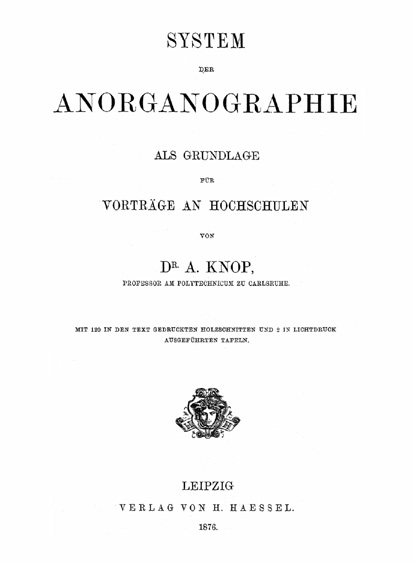KNOP, Adolf.
(1828 – 1893)
Knop graduated from Justus-Liebig University, Giessen, where he was professor of mineralogy and geognosy from 1857. In 1866, he was appointed a professor of mineralogy at Friderician University, Karlsruhe. In 1878, he was appointed director of the University's mineral collection.
Biographical references: Brauns, R., "Entwicklung des mineralogischen Unterrichts an der Universität Giessen," in: Akademische Festrede zur Feier des Jahresfestes der Grossherzoglich Hessischen Ludwigs Universität am 1. Juli 1904. Giessen, 1904 [p. 23-4 & 31]. • DBA: I 672, 388-390; II 724, 436-441, 457. • Hessische Biographien: 2, 477-8. • Kluth, C., "Adolph Knop (1828-1893)", Beiträge naturk. Forsch. Südwestdeutschland, 31, (1973), 171-7. • Poggendorff: 1, cols. 1283-4, 3, 730 & 4, 767. • Sarjeant, Geologists, Suppl. 1, 1986: 1, 555. • WBI.
1. German, 1867.
Molekularconstitution | Und | Wachsthum der Krystalle. | Von | Dr. Adolf Knop, | Professor Am Polytechnicum Zu Carlsruhe. | [rule] | Leipzig, | Verlag von H. Haessel. | 1867.
8°: [i]-viii, [2], [1]-96 p., illus.
Contents: [i-ii], Title page, verso "Leipzig, | Druck von Giesecke & Devrient."; [iii]-viii, "Vorwort."-dated 12 January 1867.; [1 pg], "Inhalt."; [1 pg], Blank.; [1], Sectional title page.; [2], Blank.; [3]-96, Text.
Rare. A work describing the theoretical arrangement of atoms with in a crystal. It is divided into two major parts. The first gives a long historical description of previous views of atomic structure covering the ideas of Bergman, Haüy, Dana, Bravais, and Frankenheim. The second section presents Knop's ideas on atomic arrangement.
Contents: Erster Theil. Molekularconstitution der Krystalle (p. 1-42). 1. Bergmann's und Hauy's geometrische Vorstellungen über den inneren Bau der Krystalle. 2. Dana's mechanische Vorstellungen über die Constitution der Krystalle. 3. Bravais-Frankenheim's geometrische Auffassung. 4. Chr. Wieners mechanische Auffassung der Molekularconstitution krystallinischer Körper. 5. Anordnung der Atome in den verschiedenen Krystallsystemen.Zweiter Theil. Wachstum der Krystal (p. 43-96). 1. Bezeichnung der Krystallaxen. 2. Krystallisationsversuche mit Chlorkalium. 3. Krystallisationsversuche mit Salmiak. 4. Bedeutung der Krystallaxen. 5. Veränderlichkeit der Wachsthumsrichtungen derselben Substanz unter veränderten Bedingungen. 6. Vvorkommen discontinuirlicher Wachsthumsformen an anderen, künstlich und natürlich krystallisirten Substanzen. 7. Mischungen von Chlorkalium und Chlorammonium. Bedingte Isomorphie beider Körper. 8. Zusammenhang zwischen Wachsthumsrichtungen und Spaltbarkeit. 9. Beziehungen zwischen Wachsthumsrichtungen und Zwillingsbildung. Schlussbemerkungen.
Bibliographical references: NUC.

2. German, 1876.
System | Der | Anorganographie | Als Grundlage | Für | Vorträge An Hochschulen | Von | Dr. A. Knop, | Professor Am Polytechnicum Zu Carlsruhe. | Mit 120 In Den Text Gedruckten Holzschnitten Und 2 In Lichtdruck | Ausgeführten Tafeln. | [ornament] | Leipzig | Verlag Von H. Haessel. | 1876.
8°: xxviii, 296 p., 2 plates, 120 illus.
Rare. By the late nineteenth century, chemistry and mineralogy were considered two distinct studies, although earlier in their history they were considered one and the same. Mineralogy had developed into a study of the materials, characteristics, properties and chemistry of various objects that naturally form part of the earth's crust. Using this image, Knop did not think minerals belonged to a special class of materials, but should in fact be treated as objects of general inorganic chemistry. He therefore called his mineralogy "Anorgranographie" and wrote a textbook on the subject that he titled, \t{System the Anorganographie} (Leipzig, 1876). In this work, he gives a classification of minerals together with all the chemical elements known at the time, as well as some naturally occurring organic compounds. Although this volume does propose a mineral system based on chemistry, it is so mixed with the other materials Knop includes as to be almost unrecognizable.
Bibliographical references: Dana's 7th (Bibliography): 75. • NUC. • Poggendorff: 1, cols. 1283-4, 3, 730 & 4, 767. • Sarjeant, Geologists, Suppl. 1, 1986: 1, 555.
.